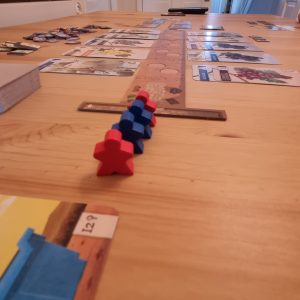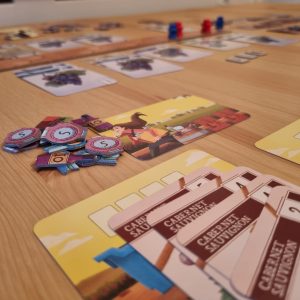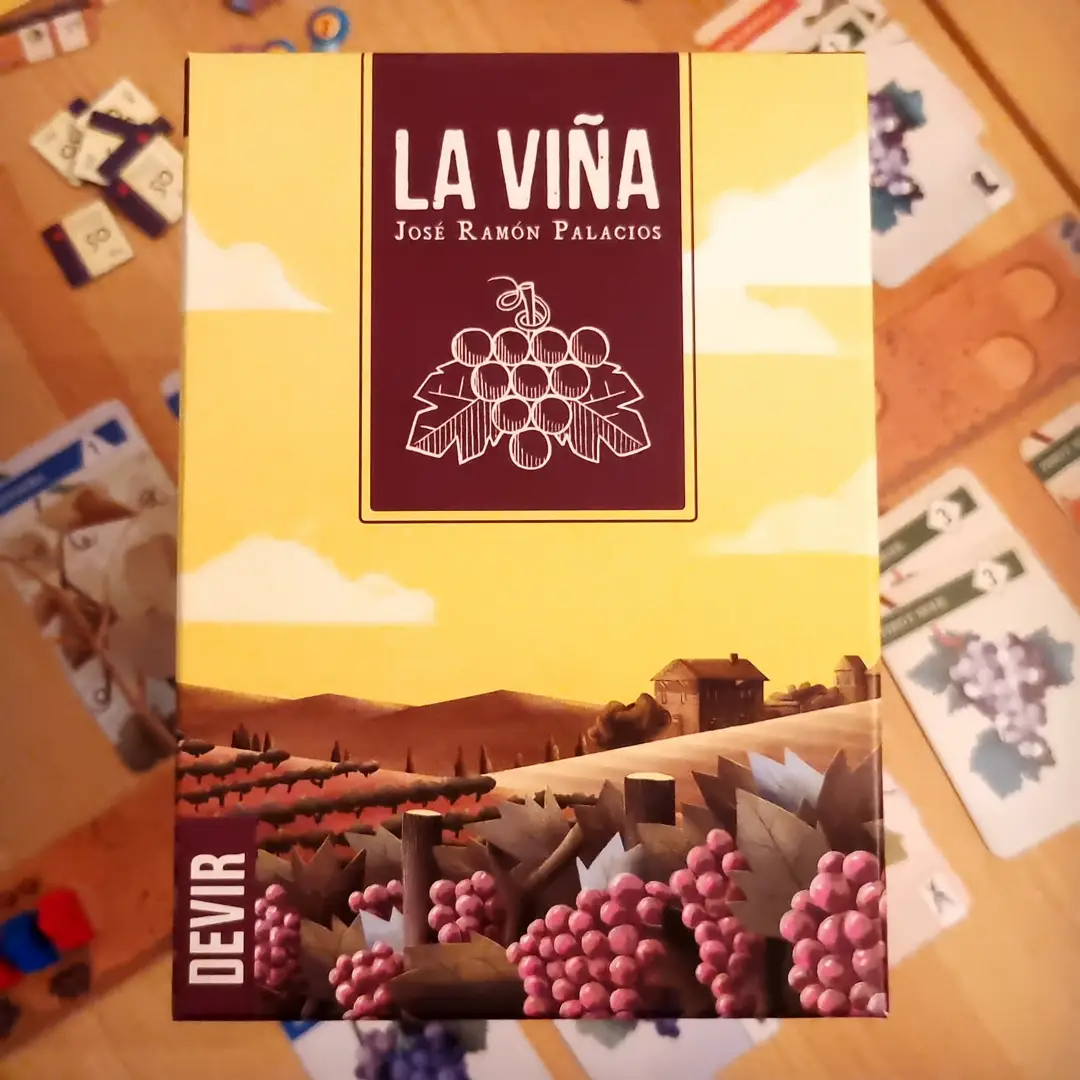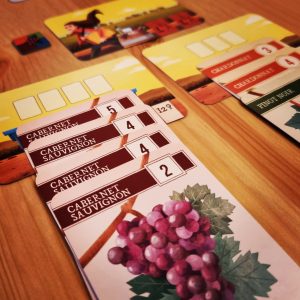Publisher: DEVIR, KOSMOS
Designer: Jose Ramon Palacios
Artist: Juan Guardiet
Release date: 2019
Players: 2-5
Age: 8+
45 mins
Favouritefoe score: 8/10
Learn More
Please click below to see my 1 minute rapid review video of La Viña
* Set Collection * Hand Management * Card Drafting * Shared Objectives *Variable Turn Order * Easy Scoring *
Whether you like a cheeky Chardonnay, or a perky Pinot Noir, La Viña from Devir will have you picking grapes like a veritable vintner!
Harvesting grapes to satisfy demanding wineries can be hard but rewarding work. And, if you want the prestige of being the best in the biz, grafting those vines into fine wines is the only way to do it!
But did La Viña leave us satisfied, or did we finish with a sour taste in our mouths? Read on to find out!
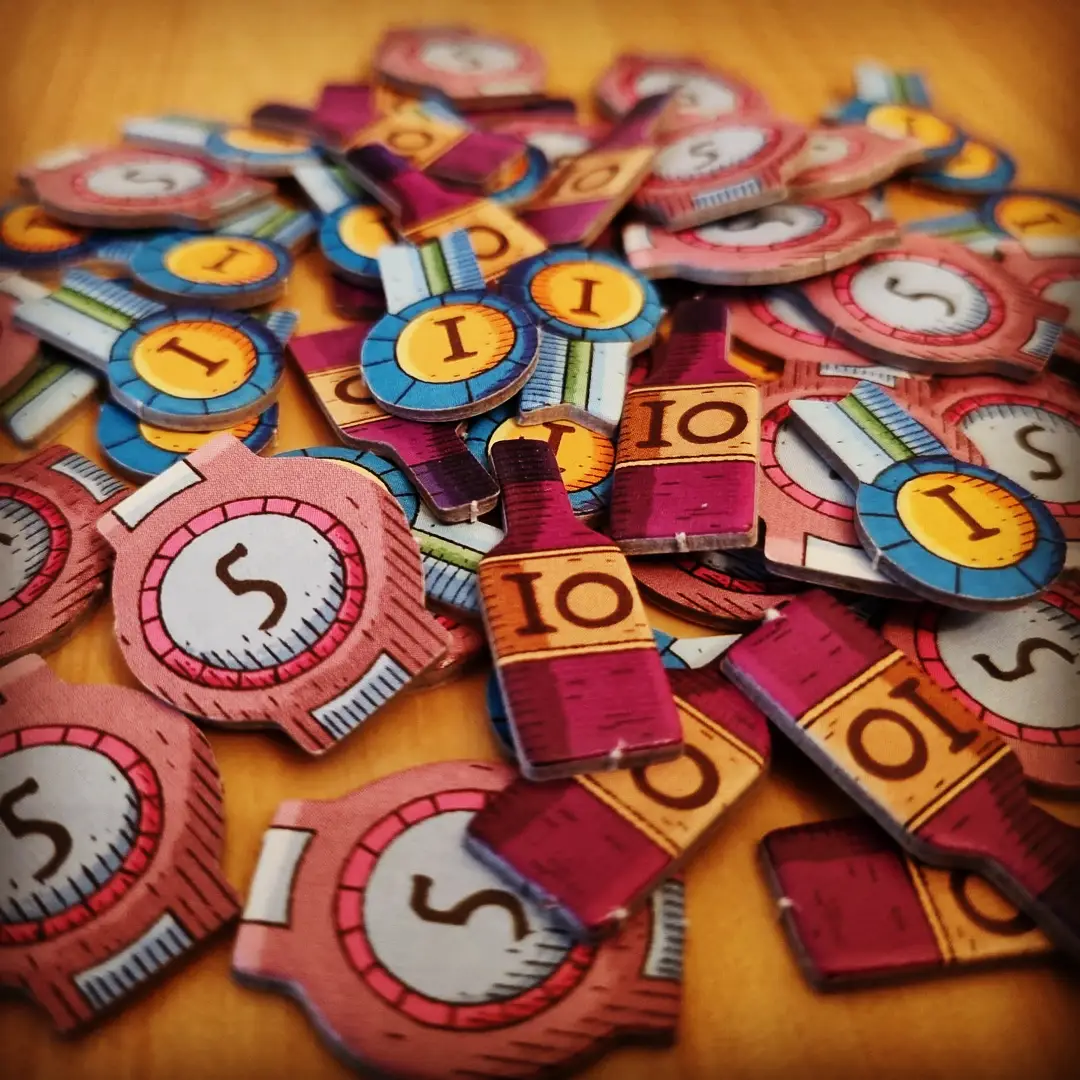
Small Glass, Big Bottle!
First up, La Viña is a small box with a bigger game feel. There are a lot of bits included which surprised us when we unpacked everything. Tokens aplenty, there are tiny wine bottles, rosettes, barrels, tools….There is also a heap of cards, as well as a modular scoring track (presumably so that it could fit inside its diminutive cardboard home!).
Not a huge fan of overly “bitty” games, I prefer to spend time playing rather than setting up and tearing down. As such, I was a little worried when the popping didn’t seem to know any end. But, having picked out and piled, shuffled and sorted, unfolded and organised, we were ready to dive in.
And set up is fairly straight forwards. Depending on how many players you have, you will click together and lay out the appropriate side of the vineyard scoring track. Then, you lay out Grape cards on each side of the track, placing the remaining pile off to one side. Some randomly chosen winery cards are placed within sight of everyone, and a wild tile is seeded at the end of the track. Each player also receives a specific number of basket cards, some special tools, and their little wooden wine makers.
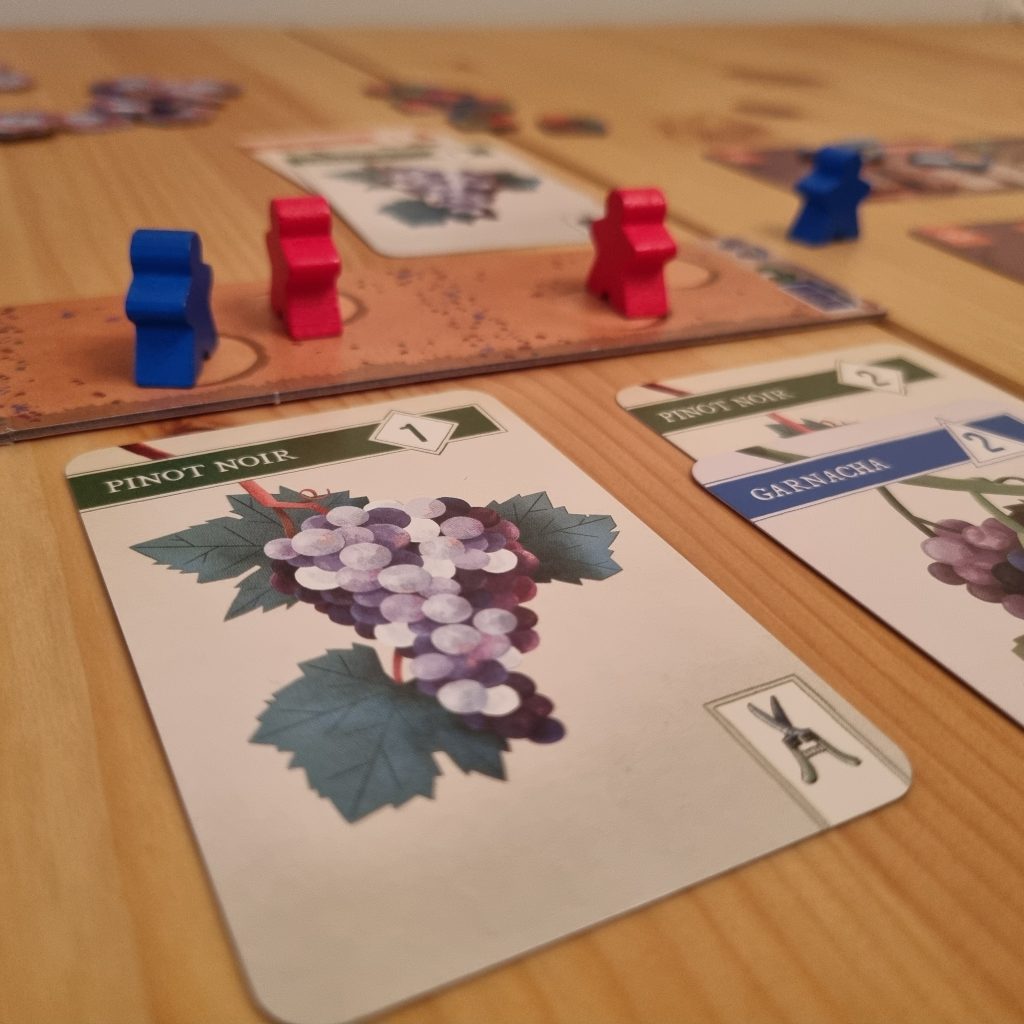
Players Pick a Peck of Pickled Pinots!
So, how do you make these fine wines that will reward you with plenty of prestige? Having inherited an old vineyard that has seen better days, you will be going picking. Grape card picking to be precise. With one eye on the needs of the wineries at the end of the vineyard track, and the other on the grapes ripe for harvesting, you’ll be filling your baskets with delicious and desirable varieties in the hope of fetching a good price!
And the mechanics are simple to master. On your turn, you will pick a spot along the vineyard track and move your meeple to it. Taking the top card from the corresponding Grape card column, you add it to one of your baskets. Beware, however, as each carrier can only hold as many Grape cards as are shown on them (2,3 or 4). If you can’t hold a card, you have to discard it.
Luckily, whilst most wineries are quite particular about the grape groups they will accept, there is one that takes a much less strict approach. As a result, whilst you won’t get as many points as you would for being a purist, you may be able to dump your undesirables into the bargain basement Co-operative barrel. This will clear your baskets for the next round, and gain you a few prestige in the process.
By the time you reach the end of the track, you’ll want to be holding a basket that matches at least one of the winery demands. Because, if you do, you can then place one of your barrels on a space on the relevant card. And what do barrels make? Yep, you guessed it! You can take the allocated number of prestige points, and start making a lovely pile of bottles, seals, and diplomas.
As players reach the end of the track, the first player to get there will earn the wild tile (which they can then add to any group to increase their grapes by one). Plus they get to lay a barrel on any winery card they satisfy in terms of grape variety and volume, taking the corresponding prestige points.
Once all players have reached the end, they return to the start of the vineyard track, ready for another harvest. The game continues in this way until one player sells all of their barrels. At the end of that round, everybody adds up their prestige points, and the person with the most is declared the winning wine-maker.
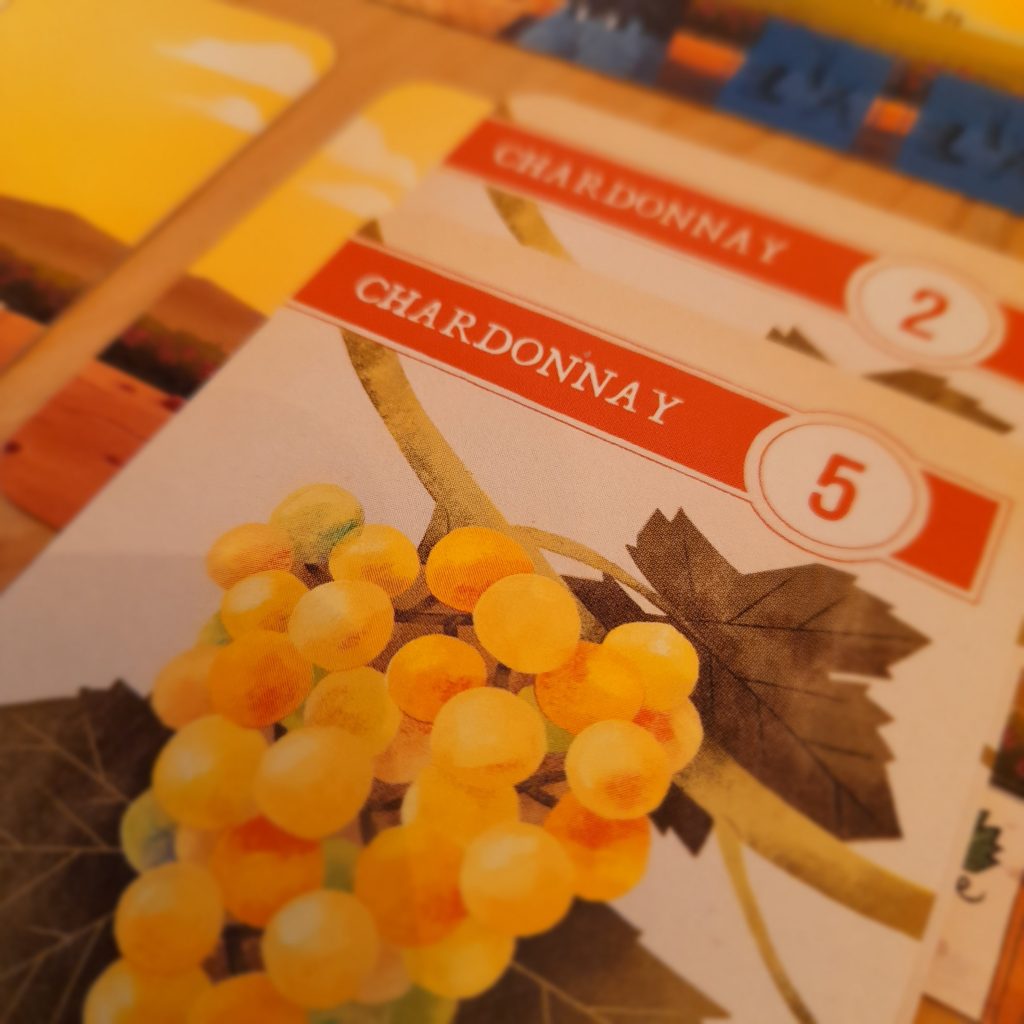
Turn Order Antics!
If you have played Tokaido (or even Patchwork) before, the turn order in this game will come as no surprise. Rather than each player taking their turn in the same order, the player who is at the back of the line gets to go. Now, that could well mean the same player taking multiple turns in succession if they linger at the back, that is). But, that tactic won’t last too long, as players in La Viña cannot occupy the same space on the vineyard track.
And this, I think, is where La Viña earns its waxy seal of approval from us. Whilst there are a lot of set collection games out there, this one forces you to make a trade-off. You have to balance racing ahead to get fewer, but highly prized, Grape cards, against taking a slowly slowly catchy winey meander through the vines.
Not having enough grapes to fulfil a contract can be just as bad as not having the precise grape variety needed to keep those oenophiles on the hook. No denying that you might not get the one card everyone is gunning for if you hang back like a squashed Shiraz. But you might be able to fill up your baskets enough to make up for the missing Merlot!
And grappling with that thinky, thorny vine is the crunchiest of fruits. In truth, it is what makes La Viña work so well for us.

Magnum Moments!
There are a few other sparkling moments in this game too. For example, scoring is a breeze. Prestige points. That’s it. Earn them at the end of each round, and add them up at the end. Nothing more complicated that that. Which, to be honest, compared to some games where you need a PhD to work out who won, is as refreshing and palate pleasing as a peppy Pinot Grigio!
The tools are also great little additions. Being able to deploy boots, shears and billhooks to take cards from previous columns, more cards, and those in covered positions, can be a strategic boon. And only having a limited supply per game adds yet another level to the decision as to which Grape cards to pick.
Similarly, being able to pay to upgrade your baskets to those with a larger capacity, is also a sensible move. Grapes don’t have to be dumped at the end of a round (although you can discard a freshly picked card or even your entire haul on any turn), so you could stockpile for another harvest. But, as with the tools, there are only a limited number, so getting there first is a race you may well want to win.

Over-ripe Rules?
I would say that the rules are probably La Viña’s only sour note. The rule book seems to make this game feel a lot more complicated than it actually is. In actual fact, it is really quite simple at heart.
Our first play was surprisingly slow, but there seemed to be a lot of reading involved. Once set up and familiar with the gameplay, however, we have been chugging down a game in around 30 minutes (depending on how AP prone I am being that day). Granted, each actual drafting decision is loaded with delicious deliberation. Likewise strategies mature like fine wines over time. But, the actual mechanics are simple, and game play is quite smooth, so please don’t be confused by the rule book!
Set up time has also been shortened considerably in our house by bagging and separating the bits needed for an average game. There are lots and lots of little bits, but don’t be intimidated. Get some pots, and you’ll be picking and packing in no time.
La Viña is also a versatile game. It plays well at all player counts, primarily because there are specific component numbers depending on how many are around the table to help maintain the tension. But as we generally play more 2 player mode, we have our own little kit ready to go when we fancy vying for vines! And La Viña does play very well, and at the faster end, at this more intimate number.

A Wine Old Time!
Although this card drafting, set collecting game could really be based on any number of things, I quite like the setting. I’m not sure I feel like I am actually wandering down a vineyard as I move my meeple down the aisle, but picking grapes, filling baskets, and placing little barrels in exchange for bottles and quality seals works. Having the most points at the end of a game does indeed feel prestigious!
The palette is also a little muted (especially the Card backs), which could be one reason why it hasn’t made much of a significant splash on the board gaming scene. But (whether this is intentional or not, I don’t know) the illiustrations do remind me of a hot, Spanish vineyard as the sun goes down, and I quite like that.
Having plenty of Grape cards and different wineries, each with their own requirements, helps to keep this game fresh every time it is brought to the table. Some want a pure vintage, others just want more of one variety than the others added to make up the mix.
Ultimately, I enjoy the romp along the vineyard track. Having to decide between picking lots of grapes, and going for the coveted card or two in a round is brain burny. Adding potential tools and basket upgrades into the mix also work well together to make La Viña a fruity game! It won’t keep you up all night in terms of plotting and planning your winning winery. But some tricky trade-offs in the Catalonia sun are the order of the day in La Viña, and I for one, am happy to fill my glass.
[please note that a copy of this game was kindly provided by the publisher for the purposes of this review but any opinions expressed are my own]


